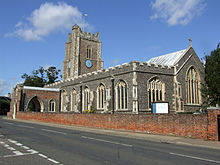St Peter and St Paul's Church, Aldeburgh
| St Peter and St Paul's Church, Aldeburgh | |
|---|---|
 St Peter and St Paul's Church, Aldeburgh | |
 | |
| 52°09′18″N 1°36′00″E / 52.154952°N 1.5999055°E | |
| Location | Aldeburgh |
| Country | England |
| Denomination | Church of England |
| History | |
| Dedication | St Peter and St Paul |
| Architecture | |
| Heritage designation | Grade II* listed |
| Administration | |
| Diocese | Diocese of St Edmundsbury and Ipswich |
| Archdeaconry | Suffolk |
| Deanery | Saxmundham |
| Parish | Aldeburgh |
St Peter and St Paul's Church, Aldeburgh is a Grade II* listed parish church in the Church of England[1] in Aldeburgh, Suffolk.
History
The church tower dates from the 14th century, but much of the rest is 16th century, including the nave, north aisle and north chapel of 1525-1529; the south aisle and chapel 1534-1535; the south porch of 1539 and the chancel 1545. It was restored between 1870 and 1871 by Henry Perkin and again in 1891 by EF Bishop.
Memorials
There is a memorial by Thomas Thurlow to George Crabbe the poet (d. 1832) and a monument to Lady Henrietta Vernon, d.1786. The church is most famous as being the burial place of Benjamin Britten and Peter Pears; also buried in the churchyard are Elizabeth Garrett Anderson, Joan Cross and Imogen Holst. Britten is also commemorated in a stained glass window by John Piper and Patrick Reyntiens. The church also houses a memorial to Newson Garrett and his wife, the parents of Elizabeth Garrett Anderson.
-
Benjamin Britten by Arno Drucker
-
Peter Pears by Arno Drucker
Organ
The church has a two manual pipe organ by J. W. Walker & Sons Ltd dating from 1884. A specification of the organ can be found on the National Pipe Organ Register.[2]
References
- ^ The Buildings of England: Suffolk: Nikolaus Pevsner.
- ^ http://npor.org.uk/cgi-bin/Rsearch.cgi?Fn=Rsearch&rec_index=D01660


